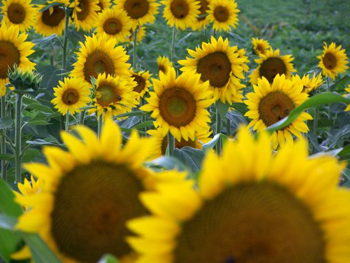
Ancient farmers were growing sunflowers in Mexico more than 4,000 years before the Spaniards arrived, according to a team of researchers that includes Florida State University anthropologist Mary D. Pohl.
In an article published in the journal PNAS (Proceedings of the National Academy of Sciences), Pohl and lead author David Lentz of the University of Cincinnati said their evidence confirms that farmers began growing sunflowers in Mexico by 2600 B.C. The paper is in response to scientists who still believe that sunflowers were first domesticated as an agricultural crop in eastern North America and that the Spaniards introduced the sunflower to Mexico from further north.
“The evidence shows that sunflower was actually domesticated twice—in Mexico and then again hundreds of miles away in the Middle Mississippi Valley,” Pohl said.
In fact, the researchers argue that after the Spanish Conquest, the Spaniards tried to suppress cultivation of the sunflower because of its association with solar religion and warfare.
José Luis Alvarado from Mexico’s Institute of Anthropology and History, Robert Bye from the Independent National University of Mexico, and UC graduate student Somayeh Tarighatis also are co-authors of the PNAS study. The research was funded by grants from the National Science Foundation and the National Geographic Society.

Pohl and Kevin Pope of Geo Eco Arc Research discovered the early domesticated remains of sunflowers a decade ago during an excavation of the San Andrés site in the modern-day Gulf Coast state of Tabasco. Alvarado found more evidence for domesticated sunflowers in a dry cave deposit at Cueva del Gallo in the west Mexican state of Morelos in the form of three large achenes, or shells.
“The Cueva del Gallo shells are in excellent condition and have unmistakable sunflower traits, removing all doubt about the pre-Columbian presence of domesticated sunflower in Mexico,” Pohl said.
Furthermore, the Mexican sunflower achenes are significantly larger than those from eastern North America, providing further evidence that the Mexican domestication was a separate process. One of the achenes was radiocarbon-dated to about 300 BC.
Ancient people used the Cueva del Gallo cave for rituals, even bringing their dead to be buried there, Pohl said. Mesoamerican people traditionally believed that caves were the conduit for the passage of the sun beneath the Earth at night and the home of fertility deities as well as the avenue of communication with their ancestors in the Underworld.
“The Cueva del Gallo sunflower shells give us another perspective on how Mexican people used sunflowers in worship and provide a clue as to why cultivation of the Mexican sunflower mysteriously disappeared after Spanish conquest,” Pohl said. “The Spanish priests probably felt that the sunflower represented both pagan worship and native political power and tried to wipe out its use.”
In addition to the physical evidence, researchers also looked at linguistic traditions to bolster their argument that sunflowers existed in Mexico before the Spaniards arrived. For example, the modern Otomi word for sunflower, dä nukhä, translates to “big flower that looks at the sun god,” a clear reference to pre-Columbian solar worship.
The San Andrés and Cueva del Gallo sunflower finds are further documentation of prehistoric Mexican peoples’ significant contribution to our repertoire of domesticated plants, Pohl said. Besides sunflowers, crops of Mexican origin include corn, peppers, beans, squash and avocadoes.




